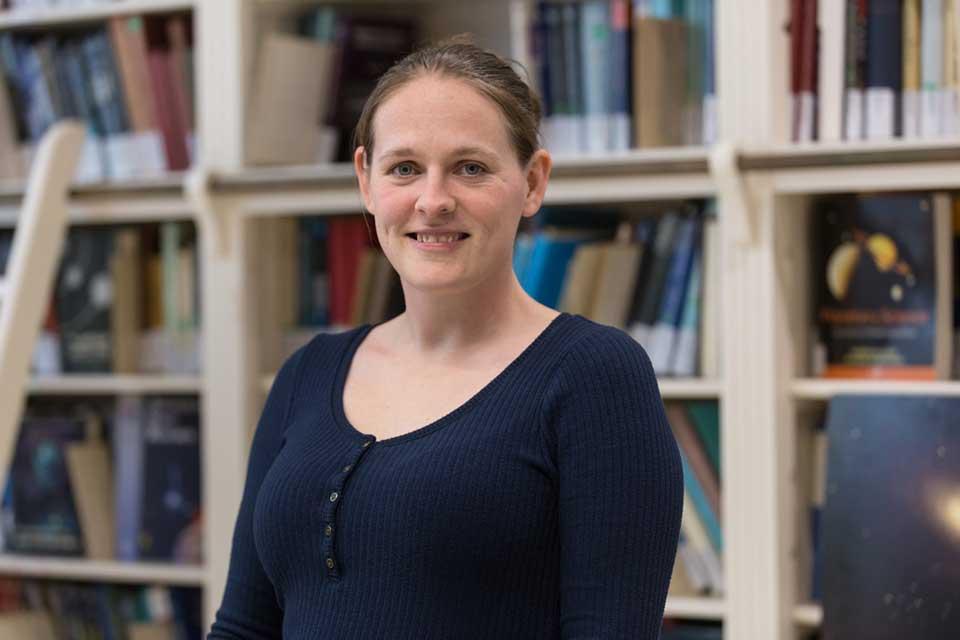Professor Jayne Birkby has been recognised by the Blavatnik Family Foundation and The New York Academy of Sciences as a finalist in the 2024 Blavatnik Awards for Young Scientists in the UK. The award recognises her work detecting water in the atmosphere of an exoplanet with robust evidence for the first time. Her work is continuously advancing cutting-edge spectroscopy and imaging techniques for exoplanet research and accelerates the quest to identify life-signalling molecules like oxygen, methane, water and carbon dioxide on nearby exoplanets.
The Blavatnik Awards for Young Scientists are independently administered by The New York Academy of Sciences; President and CEO of The New York Academy of Sciences, Professor Nicholas B Dirks, is Chair of the Awards’ Scientific Advisory Council: ‘This year’s Laureates and Finalists are pushing the boundaries of science and working to make the world a better place. Thank you to this year’s jury for sharing their time and expertise in selecting these daring and bold scientists as the winning Laureates and Finalists of the 2024 Blavatnik Awards for Young Scientists in the UK.’
Professor Birkby’s research in her own words:
The ongoing search for a second Earth has revealed an astounding diversity in planets orbiting other stars. This eclectic zoo of other worlds shows little similarity with our own solar system. From its roasted gas giants to its rocky lava worlds awash with magma oceans, the exoplanet zoo points to a vast wilderness of outcomes from the same planet formation process that also led to the emergence of life on Earth. My research looks to these extreme worlds to better understand our place among the cosmos, to know the prevalence of habitable worlds throughout our galaxy, and to study how the atmospheres of this rich plethora of worlds evolve and diverge. Ultimately, I seek the detection of biosignatures, the telltale combination of molecules (eg oxygen, methane, water, and carbon dioxide) that could signal life on the nearest rocky exoplanets. The end of this decade will see first light with the Extremely Large Telescope (ELT), a 39-m class ground-based observatory that for the first time in human history will have the technological power to detect such biosignatures on nearby exoplanets. My research career to date has forged a path to enable this game-changing discovery.
In 2013, I helped pioneer the high resolution spectroscopy (HRS) cross-correlation technique for exoplanets by making the first unambiguous detection of water in the atmosphere of a planet outside our solar system (Birkby et al. 2013). This success with ground-based 8-m class telescopes was a great leap forward for exoplanet research, signifying that the ELT will allow us to finally search for biosignatures and signs of habitability in the nearest rocky worlds. It may be our only avenue in the near future to do this, with suitable direct imaging space missions still decades away. The success of HRS opened a floodgate to entire new areas of exoplanetary science. I helped show that by combining HRS with high contrast imaging (HCI), we unlock a new fundamental observable, planetary spin rate, by measuring the length of an exoplanet day, highlighting how planets gain angular momentum as they accrete from their protoplanetary disks. Furthermore, I helped demonstrate that HRS can measure high altitude winds in exoplanet atmospheres, blowing at km/s, as well as their 3D nature, probing the extremes of planetary climate physics. I published the first graduate-level textbook chapter on HRS, solidifying it as a key observational tool for exoplanets. I now use HRS for exoplanet archaeology, connecting their present-day atmospheres to their formation in protoplanetary disks to reveal the physical mechanisms that drive the extreme diversity of the exoplanet population and Earth’s place among it. My team is leading the demonstration of using HRS reflective light as the only way to reveal the key oxygen biosignature at visible wavelengths for the nearest rocky exoplanets. This work has rapidly accelerated the timeline for determining the habitability of the nearest rocky exoplanets by driving key instrument design for the ELTs to ensure they are biosignature-enabled.
Alongside searching for biosignatures in the very nearest rocky exoplanet, Proxima b, my team and I are also working towards using HRS to make maps of gas giant exoplanet atmospheres, and search for their transiting exomoons for the first time. We are also investigating the outgassed atmospheres of lava worlds, reminiscent of the very early hot Earth, to understand their interior compositions and how their atmospheres cycle materials around the planet. Oxford’s departments in Astrophysics, as well as Atmospheric, Oceanic, and Planetary Physics, and Earth Sciences constitute the ideal environment for these studies to flourish as we work towards an integrated planetary science centre that seeks to understand the diversity of rocky exoplanets, understand the origins of life on Earth, and ultimately the prevalence of life throughout our galaxy.
It means a lot to have this work recognised by the Blavatnik Awards for Young Scientists in the UK. The study of exoplanets itself is a young and rapidly advancing field in which the UK exoplanet community is a thriving success. Its discoveries are driven by the talent and hard work of many early career researchers, and I am especially thankful to my students, my team, and collaborators throughout the world, whom without none of this would have been possible. I am so thankful to be on this incredible adventure with them, knowing that there is so much more discovery ahead of us. It is a privilege and a joy to be able to explore these strange new worlds every day, and it is an honour to have the support of the Blavatnik Family Foundation as we do so.

